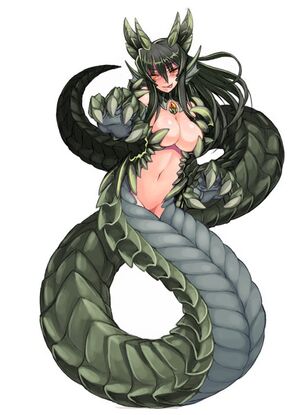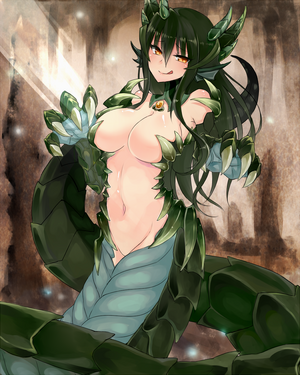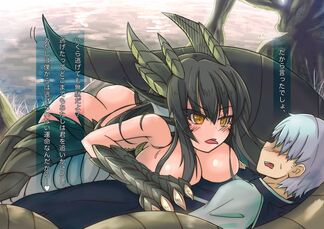
Aggressive, beautiful, sensual, deadly. The cave naga is a predator as loved as they are feared across the equestrian continent.
Appearance
The lower half of the Cave Naga is long, heavily armored and snake like,with thick scales more akin to segmentata than normal, diamond-shaped scales. The upper half resembles that of a human, save for scales around the back and side areas of their torso and the entirety of their arms, and the bioluminescent gem just above their breasts. The forward portion of their torso is very human-like in appearance, albeit often quite pale due to their cave-living and nocturnal nature. Their armored claws, while often seen as very thick and strong, are only like that when the Cave Naga tightens her hand muscles and, when relaxed, are actually very thin and delicate-looking.
Lore[]
In ancient times, the Dragons of the world, in their purest state, were incredibly virile, capable of breeding with almost any known race. Even the parthenogenetically born quetzali were not immune. These ‘dragon Quetzali’, however, were often mistaken for the feared and hated Tirek Spawn from the Great War.
Throughout the many years, these ‘Drakelings’ would often find hiding places to continue living, but the best survivors were those hiding deep in dark, inhospitable caves that few dared to tread. Over time they lost their dragon-like wings, but grew a portion of their sternum into a natural gemstone that gave off a dim, bioluminescence.
Changed vastly from their older forms, these creatures became what are now known as Cave Nagas, hiding in the deep, dark, damp caves of Equis, found almost anywhere that caves within dark areas could be found. From the frozen north to the southern dunes. Wherever there is a damp cave, one can likely find a Cave Naga.
Population
Mostly unknown, due to solitary nature. It is assumed to be quite low, but not quite endangered. Males of the race are rarely seen, but not as rare as some other races in the world.
Size[]
Can get as long as 60ft in length on rare occasions, though the average is twenty to thirty, and the torso area will rarely get to 1.5 times the size of a normal human’s body.
Strength[]
The lower half of the Cave Naga is, as explained, snake like, and has enough strength to break solid granite down into a fine powder with enough effort. The upper body strength of the Cave Naga can be compared to the strength of an average Diamond Dog alpha, due to their tendency to use their armored claws to rip through solid stone.
Speed[]
Much like many large serpents, Cave Nagas are relatively slow, and can be escaped on foot with sufficient effort. However, also like many larger snakes, constrictors especially, they are almost completely silent, making them skilled ambush predators, should ‘baiting’ prey not work out.
Special ability[]

Cave Naga 'baiting' some prey.
Cave Nagas main unique trait is their ability to learn from experiences and mistakes. The longer they manage to survive in the wilds, the more dangerous they can become. It’s suggested that if meeting a particularly large or mature cave naga the wise move is to simply turn and walk away, as she likely has some form of trap set out if you manage to escape after getting too close. Also, don’t let them follow you home, she may be cute but she is not a pet, nor is she your ‘hug buddy’. It will end very badly.
Cave Nagas can also release a natural pheromone that resembles the smell of 'heat' when attracting prey. This helps attract prey, namely males.
Weaknesses[]
The Cave Naga’s gemstone, which is in truth a hard, bioluminescent bone structure, is both a strength and a weakness. The light helps them see in the dark caves and jungles they live in, and attracts unwary travelers to them, but it is also a very potent erogenous zone and a single tap can leave them incapable of action for several seconds. A more tender touch can leave one writhing and helpless. Though this is often fatal if the person doing so is already being coiled up to be crushed to death.
Cave Nagas are, also, predictably, vulnerable to very bright lights. Anything much brighter than their gem causes severe pain in their eyes and painful migraines. Sunlight outright leaves them in writhing agony.
Reproduction[]
Cave Nagas are capable of reproducing much like their draconic ancestors, with draconic virility, they can breed with almost any species known, though the chances of a proper birth are much higher with other dragons, especially with males of their own species.
Behaviour[]

More cave naga baiting antics
Unlike the slightly similar Quetzali of the rainforests, the Cave Nagas are, while still amorous, also highly aggressive, volatile, and stubborn. As what can best be described as ‘near-apex’ predators, they’re willing to fight with equally dangerous and, in the case of Shadow Stalkers, Manticores, and other apex predators from their various habitats, are willing to fight much more dangerous creatures to defend themselves, their homes, or a kill they’ve made. It’s not uncommon to find a dead cave naga not far from the battered corpse of a phyrically victorious predator that thought they were worth the fight.
An odd behavior of theirs stems from their biological relation to the Quetzali. On rare occasions a Cave Naga will find a prey item that, due to circumstances, they imprint on as a mother figure. This has most often happened with travelers whom have been severely injured before the Naga found them. Upon imprinting, the cave naga becomes violently protective of them, though their voraciousness and libido will often cause issues with their ‘children’. Speak with Lord-Captain Griffin for further details on this.
Intelligence[]
Cave Nagas in the wild are capable of simple planning and problem solving, making them none too bright compared to most travelers, but still smarter and more dangerous than the average non-magical predatory animal. In captivity, however, their ability to learn allows them to, roughly, match the average intelligence of an adult pony or human if given enough time and patience.
Lifespan[]
In the wilds, Cave Nagas usually live roughly 80 to 85 years. The few seen in captivity, however, usually live much longer at roughly 120 to 150 years, much akin to the average lifespan of a normal pony.
Diet[]

A hungry cave naga having ensnaired some prey for the evening
Cave Nagas are omnivorous creatures, preferring to eat highly nutritious food. They have two ways to eat. One is through the human parts mouth, with which they are capable of ingesting a standard omnivorous diet. While the second method is a second, significantly larger, albeit toothless mouth located just beneath their reproductive organs. This ‘mouth’ is commonly mistaken for a pair of human-like legs, but the opening behind those ‘lips’, is, in truth, the massive stomach within their tail, which is a continuation of their existing digestive tract. This second mouth is commonly used in their nocturnal hunts to feed on larger prey whole, usually any horny and/or unwary ponies or Bast that they manage to bait in, or other less ‘fun’ prey that they crush and kill with their coiling tails.
Location[]
As their name implies, cave nagas live In caves, usually deep ones with water inside, and in darker, heavily wooded areas with large amounts of prey, like the Southern Rainforest and the Everfree Forest.
Appearance in Stories[]
(Please Add)